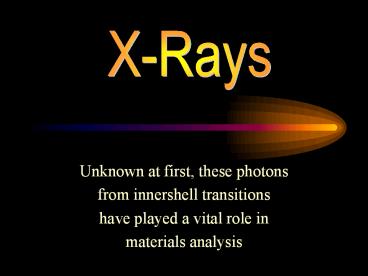Unknown at first, these photons - PowerPoint PPT Presentation
Title:
Unknown at first, these photons
Description:
Unknown at first, these photons from innershell transitions have played a vital role in materials analysis X-Ray Generation Where do X-Rays come from? – PowerPoint PPT presentation
Number of Views:102
Avg rating:3.0/5.0
Title: Unknown at first, these photons
1
X-Rays
- Unknown at first, these photons
- from innershell transitions
- have played a vital role in
- materials analysis
2
X-Ray Generation
- Where do X-Rays come from?
3
Source of X-rays as vacancy filled by cascade of
electrons from lower energy levels
4
X-Ray Generation
- X-ray tube
- ? Filament (Tungsten)
- ? Target metal (Cu, Cr)
- ? Electrons are accelerated by a potential
of about 55,000 Volts
5
Continuous X-Ray Spectrum
- 35 keV electrons strike the metal target
- They collide with the electrons in the metal
- Rapid deceleration results in emissions of proton
- Photons with a wide range of energies are emitted
because the degree of deceleration is different
6
Characteristic X-Ray
- The incident e- collides with an e- from a cores
level (K shell) - An e- in the core level escapes
- The vacant K shell can be filled by a core
electron from a higher energy level - A photon is emitted during this transition
- Specific energies are emitted since the core e-
energy levels are well-defined
7
X-Ray Diffraction
- Waves interact with crystalline structures whose
repeat distance is about the same the wavelength. - X-rays scattered from a crystalline structure
constructively interferes and produces a
diffracted beam.
8
Braggs Law
- n ? 2d sin?
- n integer
- ? wavelength (Å)
- d interatomic spacing (Å)
- ? diffraction angle (?)
9
Diffractometer
- A Chiller
- B Regulator
- C Computer
- D Strip chart recorder
10
- E X-ray source
- F ? compensating slit
- G Sample chamber
- H Scintillation counter
- J Goniometer
11
Diffraction Pattern
- Diffraction patterns are a plot of intensity vs ?
12
Sample Type
- Single Crystal
- Sample is placed in a beam and the reflections
are observed for specific orientations - Time consuming and difficult to orient the
crystal
- Powder Sample
- Many small crystallites with random orientations
- Much easier to prepare and one can see
reflections in all directions
13
Analyzing a powder sample
14
X-Ray Fluorescence Spectrometry
- What is it?
- How does it work?
- Properties
- Advantages
- Disadvantages
15
X-Ray Fluorescence Spectrometry? What is it?
- Instrumental method of qualitative and
quantitative analysis for chemical elements - Based on the measurement of the wavelength and
intensities of elements spectral lines emitted
by secondary excitation
16
X-Ray Fluorescence Spectrometry? How does it
work?
- A beam of sufficiently short-wavelength X
radiation irradiates the sample - Excites each chemical element to emit secondary
spectral lines - Spectral lines have wavelengths characteristics
- This process is known as the secondary excitation
17
X-Ray Fluorescence Spectrometry? How does it
work? (continued)
- Sample can have practically any form
- Sample size and shape can be largely varied
- The material to be analyzed can be almost
anything
18
X-Ray Fluorescence Spectrometry? Properties
- The intensities of the resulting fluorescent
X-rays are smaller - The method is feasible only when high-intensity
X-ray tubes, very sensitive detectors and
suitable X-ray optics are available - A certain number of quanta can reduce the
statistical error of the measurement
19
X-Ray Fluorescence Spectrometry ? Properties
(continued)
- Intensity influence the time that will be
necessary to measure a spectrum - The sensitivity of the analysis depend on the
peak-to-background ratio of the spectral lines - Few cases of spectral interference occur
20
X-Ray Fluorescence Spectrometry? Advantages
- X-ray spectra is simple and regular
- Matrix effect in X-ray emission are systematic,
predictable and readily evaluated - X-ray fluorescence spectroscopy is
non-destructive.
21
X-Ray Fluorescence Spectrometry? Disadvantages
- Small surface layer contributes to the observed
X-ray line intensity - Not all of the elements in a sample can be
measured using the same X-ray tube, crystals, and
detector
22
X-ray Applications
- Electron Microprobe
- Scattering
- Absorptiometry
- Radiography
- Fluoroscopy
23
Electron Microprobe
- Nondestructive
- determines composition of tiny amounts of solids.
- Virtually all elements can be analyzed except
hydrogen helium and lithium.
An Electron Microprobe
24
Scattering
- A fluorescence spectrometer is used on a gas,
liquid, colloidal suspension or solid. - Coherent and Incoherent scattering rays.
- Ratio of these rays are analyzed.
- Measures radius of gyrations.
- Widely used in proteins, viruses, catalysts,
hardening and precipitation in alloys and lattice
deformation.
25
Absorptiometry
- Chemical analysis is possible for gases, lipids
or solids to measure densities porosities as well
as coating, plating and insulation thickness. - Most often applied to living patients in
measurements of bone densities, iodine in the
thyroid gland, liver diseases and other medical
uses. - Two types Single and Dual X-ray Absorptiometry.
26
Single X-ray Absorptiometry
- Single X-ray absorptiometry is used to measure
the bone mineral content. - Used for diagnosis of osteoporosis, providing
reasonable accuracy and precision and low
radiation exposure.
27
Dual X-ray Absorptiometry
- Used when single X-ray absorptiometry is not
feasible. - Used in areas with variable soft tissue and
composition such as the spine, hip or the whole
body.
A Dual X-ray Absorptiometry
28
Radiography
- Involves use of registration on film of the
differential absorption of a beam passing through
a specimen. - Medical uses.
- Industrial uses.
- Nondestructive method.
29
(No Transcript)
30
Fluoroscopy
- Similar to radiography except the image is
registered on a fluorescent screen. - Instantaneous and permits observation of internal
motions and other changes.
31
Auger electron spectrometer

